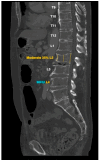Clinical Validation of Commercial AI Software for the Detection of Incidental Vertebral Compression Fractures in CT Scans of the Chest and Abdomen
- PMID: 40564850
- PMCID: PMC12192034
- DOI: 10.3390/diagnostics15121530
Clinical Validation of Commercial AI Software for the Detection of Incidental Vertebral Compression Fractures in CT Scans of the Chest and Abdomen
Abstract
Background/Objectives: The objective of this study was to clinically validate the performance of the Nanox.AI HealthOST software in detecting incidental vertebral compression fractures (VCFs) on outpatient chest and abdomen CT scans using sensitivity, specificity, positive predictive value (PPV), and negative predictive value (NPV). A secondary aim was to assess the rate of missed VCFs using initial radiologist reports. Methods: A retrospective analysis was performed on 590 outpatient CT scans. HealthOST, an artificial intelligence solution from Nanox.AI that allows for automated spine analysis using CT images was evaluated against a consensus ground truth established by two radiologists, including a senior musculoskeletal radiologist. Two vertebral body height reduction thresholds were tested: mild (>20%) and moderate (>25%). Original radiologist reports were reviewed to identify missed VCFs. Results: At the 20% threshold, the AI achieved a sensitivity of 92.0%, a specificity of 52.7%, a PPV of 16.5%, and an NPV of 98.5%. At the 25% threshold, sensitivity decreased to 78.0%, while specificity improved to 94.2%, with a PPV of 51.1% and an NPV of 98.2%. The AI identified 88% and 92% of fractures missed by radiologists at the 20% and 25% thresholds, respectively. Conclusions: The Nanox HealthOST AI solution demonstrates potential as an effective screening tool, with threshold selection adaptable to clinical needs with a secondary review by a radiologist that is advisable to ensure diagnostic accuracy. The study further indicates that radiologists often overlook VCFs in reporting non-indicated cases and that AI has a role in enhancing the detection and reporting of vertebral compression fractures in routine clinical practice.
Keywords: artificial intelligence; osteoporosis; spine imaging; vertebral compression fractures.
Conflict of interest statement
The authors Vinu Mathew, Dawn Pearce, Sidharth Saini, and Noah Kates Rose declare that they have no conflicts of interest to disclose. Earl Bogoch received an unrestricted research grant from Amgen Canada Inc., with full control retained over the project’s design, execution, and publication.
Figures


Similar articles
-
Implementation of an AI Algorithm in Clinical Practice to Reduce Missed Incidental Pulmonary Embolisms on Chest CT and Its Impact on Short-Term Survival.Invest Radiol. 2025 Apr 1;60(4):260-266. doi: 10.1097/RLI.0000000000001122. Epub 2024 Oct 9. Invest Radiol. 2025. PMID: 39378217
-
Signs and symptoms to determine if a patient presenting in primary care or hospital outpatient settings has COVID-19.Cochrane Database Syst Rev. 2022 May 20;5(5):CD013665. doi: 10.1002/14651858.CD013665.pub3. Cochrane Database Syst Rev. 2022. PMID: 35593186 Free PMC article.
-
Artificial intelligence for detecting keratoconus.Cochrane Database Syst Rev. 2023 Nov 15;11(11):CD014911. doi: 10.1002/14651858.CD014911.pub2. Cochrane Database Syst Rev. 2023. PMID: 37965960 Free PMC article.
-
Deep learning-driven incidental detection of vertebral fractures in cancer patients: advancing diagnostic precision and clinical management.Radiol Med. 2025 Aug 2. doi: 10.1007/s11547-025-02058-z. Online ahead of print. Radiol Med. 2025. PMID: 40751896
-
Rapid, point-of-care antigen tests for diagnosis of SARS-CoV-2 infection.Cochrane Database Syst Rev. 2022 Jul 22;7(7):CD013705. doi: 10.1002/14651858.CD013705.pub3. Cochrane Database Syst Rev. 2022. PMID: 35866452 Free PMC article.
References
-
- Public Health Agency of Canada Osteoporosis and Related Fractures in Canada: Report from the Canadian Chronic Disease Surveillance System. [(accessed on 8 June 2025)]. Available online: https://www.canada.ca/en/public-health/services/publications/diseases-co....
-
- Bell A., Kendler D.L., Khan A.A., Shapiro C.M.M., Morisset A., Leung J.-P., Reiner M., Colgan S.M., Slatkovska L., Packalen M. A Retrospective Observational Study of Osteoporosis Management after a Fragility Fracture in Primary Care. Arch. Osteoporos. 2022;17:75. doi: 10.1007/s11657-022-01110-z. - DOI - PMC - PubMed
-
- Kendler D.L., Adachi J.D., Brown J.P., Juby A.G., Kovacs C.S., Duperrouzel C., McTavish R.K., Cameron C., Slatkovska L., Burke N. A Scorecard for Osteoporosis in Canada and Seven Canadian Provinces. Osteoporos. Int. J. Establ. Result Coop. Eur. Found. Osteoporos. Natl. Osteoporos. Found. USA. 2021;32:123–132. doi: 10.1007/s00198-020-05554-2. - DOI - PMC - PubMed
-
- McArthur C., Lee A., Alrob H.A., Adachi J.D., Giangregorio L., Griffith L.E., Morin S., Thabane L., Ioannidis G., Lee J., et al. An Update of the Prevalence of Osteoporosis, Fracture Risk Factors, and Medication Use among Community-Dwelling Older Adults: Results from the Canadian Longitudinal Study on Aging (CLSA) Arch. Osteoporos. 2022;17:31. doi: 10.1007/s11657-022-01073-1. - DOI - PMC - PubMed
Grants and funding
LinkOut - more resources
Full Text Sources

